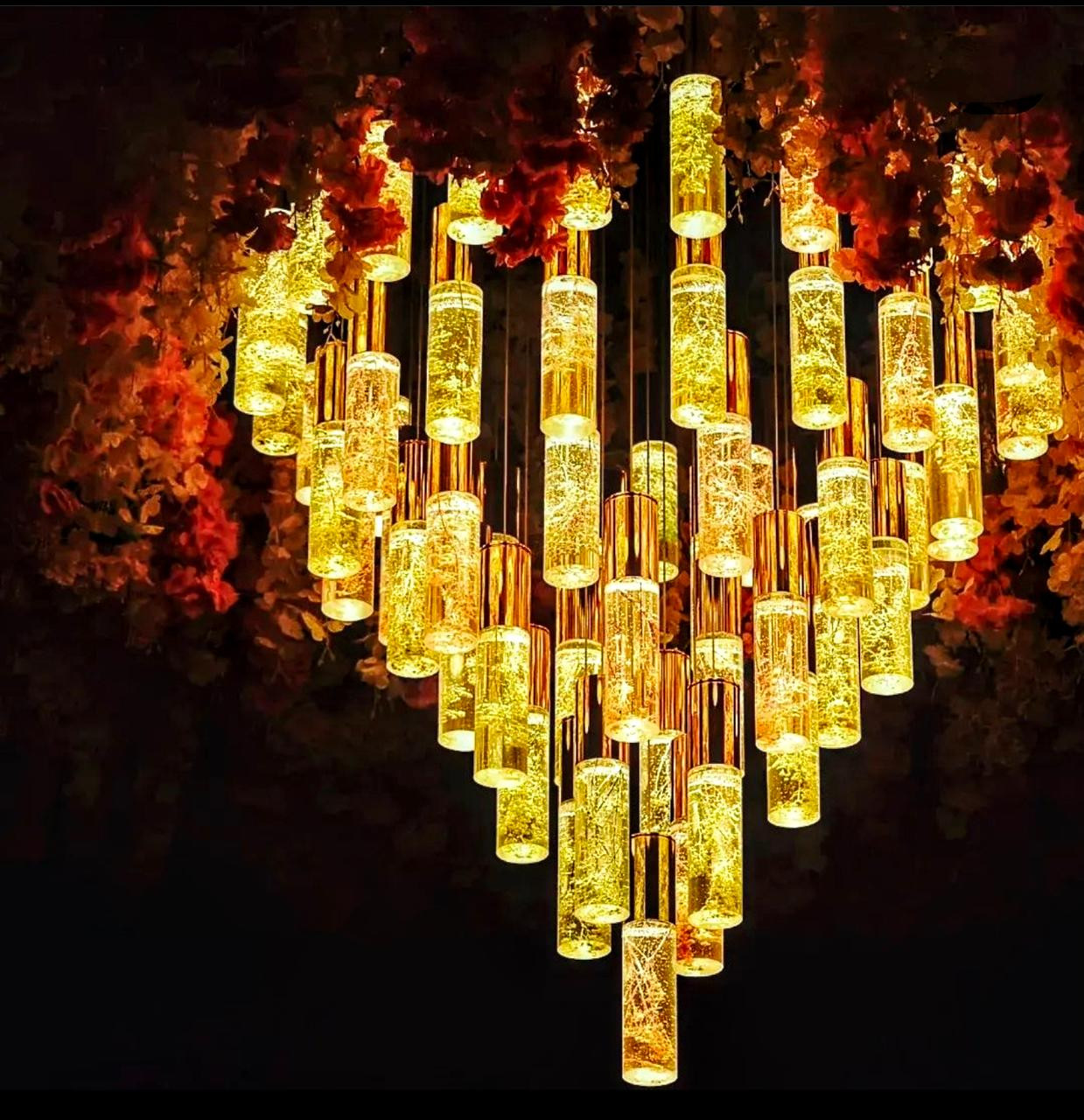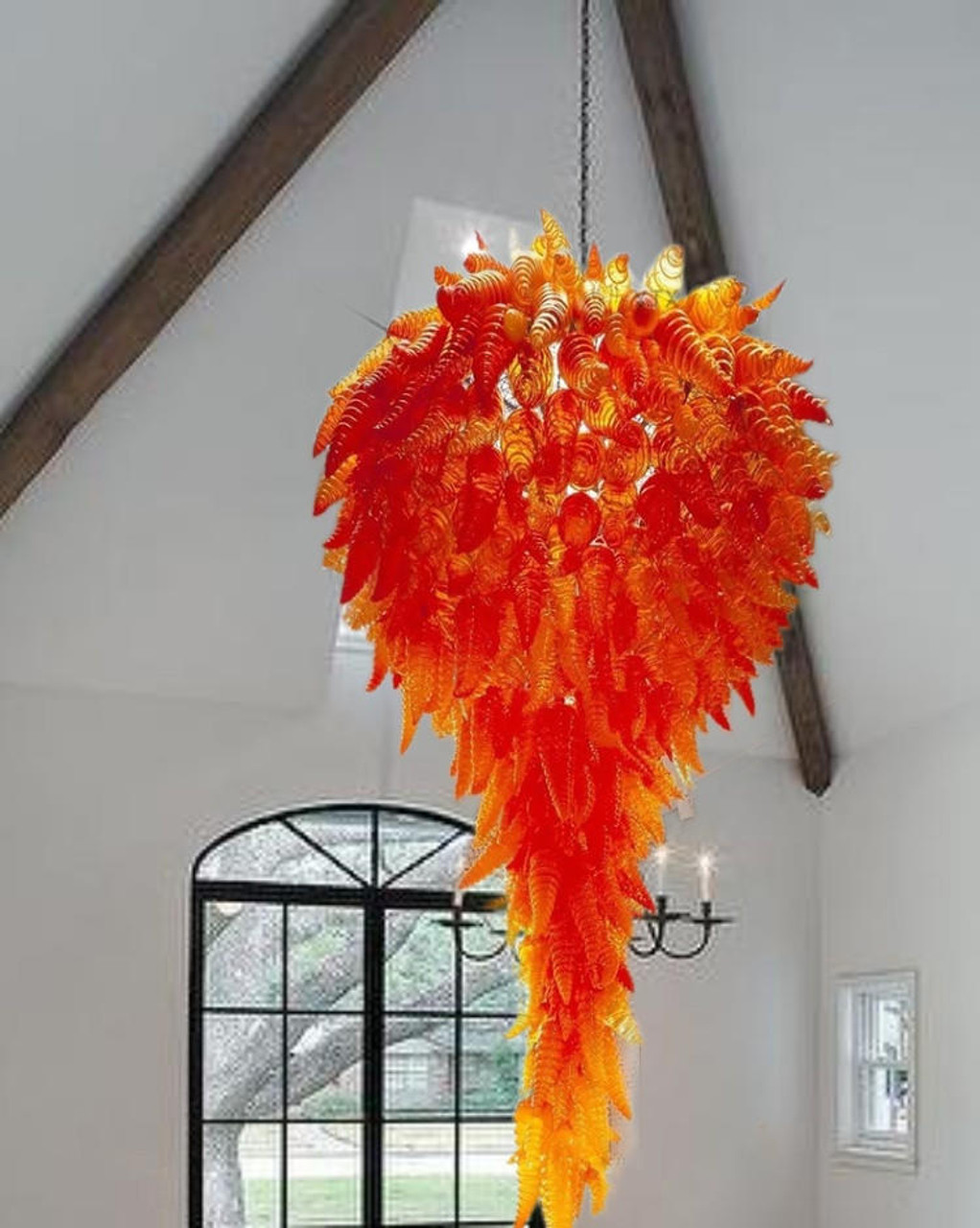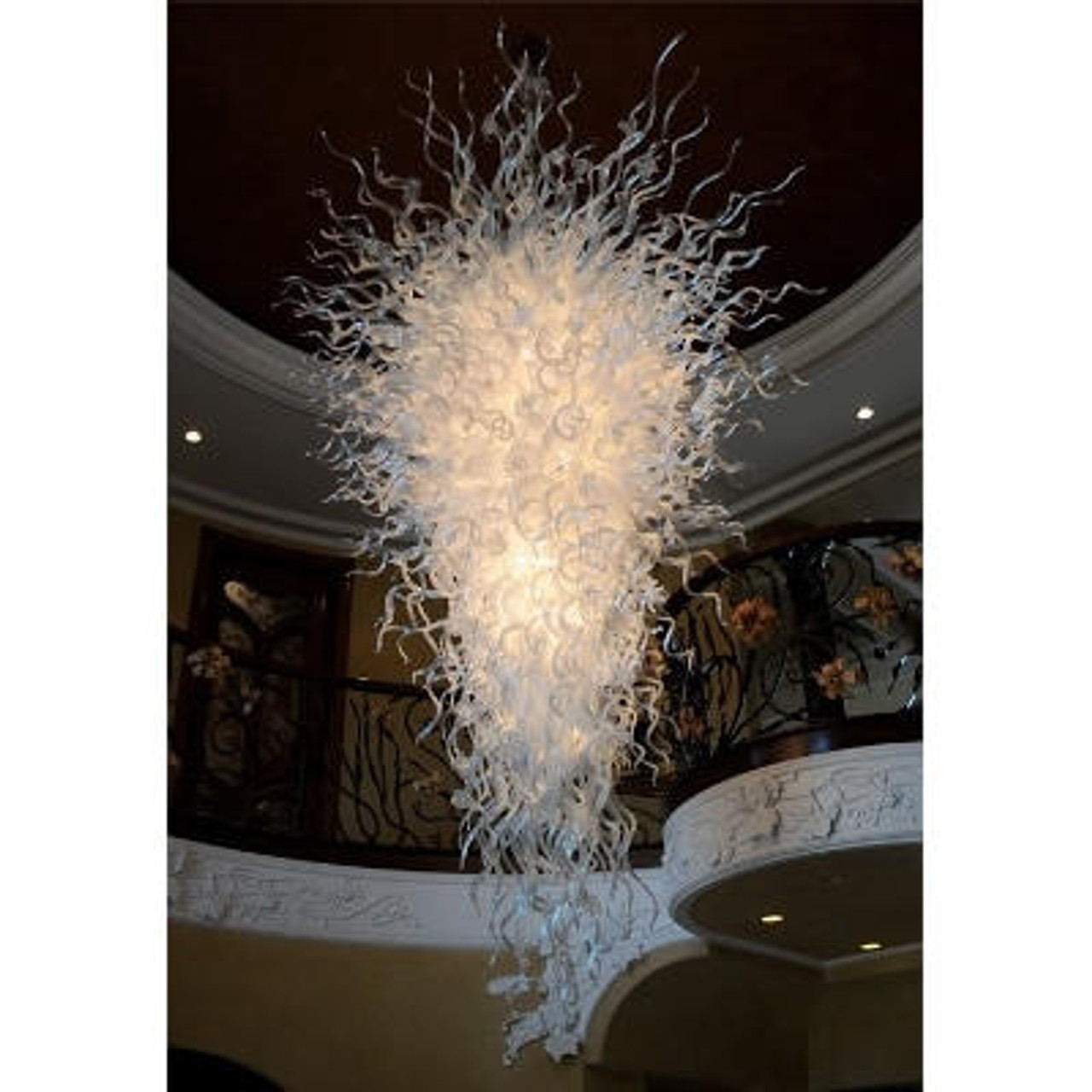The Art of Light: Exploring the History and Craftsmanship Behind Chihuly Glass Chandeliers
Aug 21, 2024
The Art of Light: Exploring the History and Craftsmanship Behind Chihuly Glass Chandeliers
Glass has always held a certain magic—a combination of fragility, fluidity, and the way it interacts with light that captures the imagination. No one has harnessed that magic quite like Dale Chihuly. As one of the most prominent figures in the world of contemporary glass art, Chihuly's work, particularly his glass chandeliers, has redefined the medium and transformed it into a dynamic form of artistic expression. This article delves into the rich history and intricate craftsmanship of Chihuly glass chandeliers, exploring how these stunning pieces of art are made, the evolution of Chihuly's techniques, and the impact these chandeliers have had on contemporary art and design.
Introduction to Dale Chihuly and His Legacy
A Brief Overview of Dale Chihuly's Career and His Influence on the Glass Art World
Dale Chihuly, born in 1941 in Tacoma, Washington, has been a pioneering force in the world of glass art for over five decades. His journey into glass began during his studies at the University of Washington, where he first encountered the material that would define his career. After further studies at the Rhode Island School of Design (RISD) and a transformative stint at the Venini glass factory in Murano, Italy, Chihuly's approach to glass art evolved into something entirely new. He introduced a collaborative team approach to glassblowing, drawing parallels to the methods used by painters and sculptors who work with assistants to bring their visions to life on a grand scale.
Chihuly’s influence on the glass art world cannot be overstated. He is credited with pushing the boundaries of what glass art can be, transforming it from a craft into a legitimate art form that can command the same respect and admiration as painting and sculpture. His work has been exhibited in major museums and public spaces around the world, captivating audiences with its vibrant colors, organic forms, and the sheer scale of his installations.
The Significance of His Chandeliers in the Broader Context of His Work
Among Chihuly’s vast body of work, his glass chandeliers hold a special place. These massive, intricate structures are not just functional objects; they are works of art that redefine the spaces they inhabit. Chihuly's chandeliers are a culmination of his explorations in color, form, and light, each one a unique reflection of his creative vision. The chandeliers are significant not only because of their beauty but also because they represent Chihuly's ability to transform the traditional notion of a chandelier into something entirely new and unexpected. Through these works, Chihuly has expanded the possibilities of what glass can do, making his chandeliers a vital part of his legacy.
The History of Chihuly Glass Chandeliers
Early Inspirations and the First Chihuly Chandeliers
The concept of the glass chandelier emerged in Chihuly's work during the mid-1980s, a period of intense experimentation and innovation. His early works were inspired by his time in Venice, where he was exposed to the rich tradition of Venetian glassblowing. However, Chihuly’s approach was distinctly his own, blending traditional techniques with modern sensibilities to create something entirely original.
The first Chihuly chandeliers were part of his installation at the 1992 Seattle Art Museum exhibition. These early chandeliers were more subdued in scale and complexity compared to the ones that would follow, but they laid the groundwork for what would become one of his signature forms. The installation was a success, and the chandeliers quickly became one of Chihuly’s most recognizable motifs.
The Evolution of Chihuly’s Techniques and Designs Over the Decades
Over the years, Chihuly’s chandeliers evolved both in scale and complexity. He began to experiment with larger installations, incorporating more intricate designs and a broader range of colors. The late 1990s saw Chihuly pushing the boundaries of what was possible, creating chandeliers that were not just larger but also more dynamic, with twisting, spiraling forms that seemed to defy gravity.
One of the most significant developments in Chihuly’s chandelier work was the introduction of his "Persian" elements—exotic, flower-like forms that added a new level of detail and richness to his designs. These elements became a hallmark of his chandelier work, adding layers of complexity and depth that made each piece even more mesmerizing.
Key Milestones in the Development of His Chandelier Art
Several key milestones mark the evolution of Chihuly’s chandelier art. One of the most notable is the installation of his first outdoor chandelier at the 1996 Chihuly Over Venice exhibition. Suspended over the canals of Venice, this installation was a bold statement that demonstrated Chihuly's ability to scale his work to monumental proportions. It also marked the beginning of his exploration of chandeliers as site-specific installations, tailored to the unique characteristics of the spaces they inhabit.
Another milestone came with the installation of the Fiori di Como at the Bellagio Hotel in Las Vegas in 1998. This massive chandelier, composed of over 2,000 hand-blown glass elements, is one of Chihuly's most famous works and a testament to his ability to create works of art that are both awe-inspiring and intricately detailed.
The Craftsmanship Behind the Glass
Detailed Explanation of the Glassblowing Techniques Used in Creating Chihuly Chandeliers
The creation of a Chihuly chandelier is a complex, labor-intensive process that requires the skill and expertise of a team of highly trained artisans. At the heart of this process is the ancient art of glassblowing, a technique that Chihuly has mastered and adapted to suit his creative vision.
Each element of a Chihuly chandelier begins as a molten glob of glass, heated to over 2,000 degrees Fahrenheit. The glassblower gathers the molten glass on the end of a blowpipe and begins to shape it by blowing air into the pipe and using various tools to mold the glass. This process is repeated for each individual piece of the chandelier, with the glassblower carefully controlling the shape, size, and color of each element.
Once the individual pieces are formed, they are slowly cooled in a process known as annealing, which prevents the glass from cracking or breaking. After cooling, the pieces are assembled into the final chandelier, with each element carefully placed to create a harmonious and dynamic composition.
The Role of Chihuly’s Team of Artisans in the Production Process
While Chihuly is the creative force behind his chandeliers, he does not work alone. His chandeliers are the result of a collaborative effort between Chihuly and his team of artisans, who bring his vision to life through their technical skill and craftsmanship.
Chihuly’s team includes some of the most talented glassblowers in the world, each one a master of their craft. These artisans work closely with Chihuly, interpreting his designs and translating them into physical form. The collaborative nature of the work is essential to the success of Chihuly’s chandeliers, allowing for the creation of pieces that are greater than the sum of their parts.
The Challenges and Innovations in Creating Large-Scale Glass Installations
Creating large-scale glass chandeliers presents numerous challenges, from the technical difficulties of glassblowing to the logistical issues of assembling and installing the finished piece. One of the biggest challenges is the sheer scale of the work. Chihuly’s chandeliers can consist of hundreds or even thousands of individual glass elements, each one delicate and fragile. Assembling these elements into a cohesive whole requires careful planning and precise execution.
Over the years, Chihuly has developed a number of innovations to address these challenges. One of the most important is his use of modular construction, which allows the chandelier to be assembled in sections that can be transported and installed more easily. This approach has made it possible for Chihuly to create chandeliers of unprecedented size and complexity.
Iconic Chihuly Chandelier Installations
A Showcase of Some of the Most Famous Chihuly Chandeliers Around the World
Chihuly's chandeliers have been installed in some of the most prestigious venues around the world, each one a unique expression of his artistic vision. Some of the most famous include:
- Fiori di Como at the Bellagio Hotel, Las Vegas: This breathtaking installation is composed of more than 2,000 hand-blown glass flowers, suspended from the ceiling of the hotel’s lobby. The vibrant colors and intricate details of the flowers create a stunning display that has become one of the most iconic features of the Bellagio.
- The Rotunda Chandelier at the Victoria and Albert Museum, London: Installed in 2001, this chandelier is a striking centerpiece of the museum’s main entrance. The chandelier’s swirling, organic forms and vibrant colors create a dramatic contrast with the museum’s classical architecture.
- The Chihuly Bridge of Glass, Tacoma, Washington: This pedestrian bridge, which connects downtown Tacoma with the city’s waterfront, features a series of glass installations, including several large chandeliers. The chandeliers, which are suspended from the bridge’s roof, are composed of hundreds of glass elements in a variety of colors and shapes, creating a dazzling display of light and color.
The Stories Behind These Installations and Their Cultural Impact
Each of these installations has a unique story and cultural significance. For example, the Fiori di Como at the Bellagio was a groundbreaking work that helped to establish Las Vegas as a destination for fine art. The Rotunda Chandelier at the Victoria and Albert Museum, meanwhile, represents a fusion of old and new, blending contemporary glass art with classical architecture.
These installations have had a profound impact on the cultural landscape, elevating the status of glass art and inspiring countless artists and designers. They have also become landmarks in their own right, attracting visitors from around the world who come to marvel at their beauty and craftsmanship.
The Symbolism and Themes in Chihuly's Chandelier Designs
Exploration of Recurring Motifs and Themes in Chihuly's Chandeliers
Chihuly’s chandeliers are rich with symbolism and recurring themes, many of which reflect his deep connection to nature. One of the most prominent motifs in his work is the use of organic, flowing forms that evoke the shapes of flowers, sea creatures, and other natural elements. These forms are often combined with vibrant colors, creating a sense of movement and life that is central to Chihuly’s artistic vision.
Another recurring theme in Chihuly’s work is the idea of transformation. His chandeliers often feature elements that seem to be in a state of flux, changing shape and form as they interact with light and space. This theme is closely tied to the nature of glass itself, which can be transformed from a liquid to a solid and back again, creating a sense of fluidity and impermanence.
How These Themes Reflect Chihuly’s Artistic Vision and Philosophy
Chihuly’s use of natural forms and his exploration of transformation are not just aesthetic choices; they reflect his broader artistic philosophy. Chihuly has often spoken about his fascination with the way light interacts with glass, and his chandeliers are a manifestation of this fascination. The way the glass elements catch and refract light creates a dynamic, ever-changing display that is central to the experience of his work.
This focus on light and transformation also reflects Chihuly’s belief in the importance of innovation and experimentation. Throughout his career, he has constantly pushed the boundaries of what is possible with glass, using his chandeliers as a platform for exploring new ideas and techniques. This spirit of exploration is what has made Chihuly one of the most influential artists of his generation.
The Future of Chihuly Glass Chandeliers
Speculation on How Chihuly’s Work Will Continue to Influence Glass Art and Design
As Chihuly’s career enters its sixth decade, there is no doubt that his work will continue to influence the world of glass art and design for years to come. His chandeliers, in particular, have set a new standard for what glass art can be, inspiring a new generation of artists to explore the possibilities of the medium.
One of the ways in which Chihuly’s work is likely to continue to influence the field is through the growing trend of large-scale, site-specific installations. Chihuly’s chandeliers have demonstrated the potential of glass art to transform spaces, and many contemporary artists are following in his footsteps, creating works that are designed to interact with their surroundings in dynamic and innovative ways.
Emerging Trends in Glass Art Inspired by Chihuly’s Chandeliers
In addition to influencing the scale and scope of glass art, Chihuly’s chandeliers have also inspired a number of emerging trends in the field. One of the most notable is the increased use of color in glass art. Chihuly’s vibrant, multi-colored chandeliers have shown that color can be used not just as an accent but as a central element of the design, and many contemporary glass artists are experimenting with new ways to incorporate color into their work.
Another trend inspired by Chihuly is the use of organic forms and natural motifs. Chihuly’s chandeliers often feature shapes that evoke flowers, sea creatures, and other elements of the natural world, and this approach has been embraced by many contemporary artists who are exploring the connections between art and nature.
Conclusion
Dale Chihuly’s glass chandeliers are more than just works of art; they are a testament to the transformative power of creativity and innovation. Through his chandeliers, Chihuly has redefined what glass art can be, pushing the boundaries of the medium and inspiring a new generation of artists to explore its possibilities.
From their humble beginnings in the 1980s to their status as iconic installations in some of the world’s most prestigious venues, Chihuly’s chandeliers have left an indelible mark on the world of art and design. As we look to the future, there is no doubt that Chihuly’s influence will continue to be felt, as his chandeliers inspire new innovations and set new standards for what glass art can achieve.
In exploring the history and craftsmanship behind Chihuly’s chandeliers, we gain a deeper appreciation for the artistry and vision that have made them such an important part of our cultural landscape. These works are not just beautiful objects; they are a celebration of light, color, and the endless possibilities of glass.







